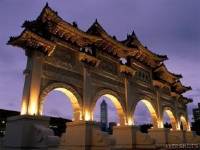Profile
Blog
Photos
Videos
Phnom Penh
Vic and I travelled to Phnom Penh from Ho Chi Minh City by bus, which meant we had to get our Visas at the border. The whole process was farcical, as they didn't need to look at my departure card (something required in each country in that area), then getting passport control to even look at our passports was difficult enough. The officer in the passport control booth just sat there, barely acknowledging anyone, while the queue before him built up. After about 30 minutes of waiting for our passports back, we were given them back with only a cursory glance, ready to leave Vietnam. It didn't get easier, as we walked the few hundred yards through 'no man's land' to the Cambodian border control, in sweltering heat.
However, gaining our Cambodian Visa was relatively simple, and following declining to give the man at luggage control a Dollar for no apparent reason, we left the building to jump on the bus (no air con, no fan) to continue onwards to Phnom Penh. The ride was extremely bumpy, but I managed to finish the book I had been reading, 'Google Whack' by Dave Gorman, which had provided much amusement through my journey so far.
Vic and I had read good things about the guest houses by the lake in Phnom Penh, so we decided to head there. We weren't to be disappointed, as the area was very chilled, and although the accomodation was basic, we had a good time there. A short walk from my room over the wooded walkway led to the decking of the bar and lounging area, which afforded great views of the lake, particularly at sunset. We didn't get to see much of the city of Phnom Penh, as our main intention was to learn more about the history of Cambodia, learning about The Killing Fields and the Khmer Rouge regime.
The Khmer Rouge, The Killing Fields and S-21 Prison.
I had read and heard the rough details about The Killing Fields from other travellers, but never from home. I believe this would apply to many people my age in the UK, so want to describe as openly as I can, some of the events that occurred in Cambodia thirty years ago. If you are squeamish, do not read this. To see the two locations, S-21 Prison and The Killing Fields takes the best part of a day, so we set off early for Taol Sleng, or S-21.
When Pol Pot's Khmer Rouge took over in 1975, he believed he had the ability to advance Cambodia faster than the other neighbouring Communist countries. In order to do this, he felt he needed to return Cambodia to the year zero and begin again. This meant removing any history from the nation, including any ties to the old Cambodia. Uprisings would be a certainty, so the only way to quell this would be to remove any potential usurpers. This included teachers, doctors, scientists, or indeed anyone who would stand in an uprising.
During Pol Pot's four year reign of terror, it is not known how many died. Some estimates say 1.5 million, but the figure is probably closer to 3 million. People would be removed from their villages for no reason, hand-cuffed and blind-folded, taken to one of the many Killing Fields in Cambodia, and disposed of. This could apply to entire familes at a time, in the most gruesome of ways. Before throwing the bodies into the large pits in the ground, mothers would be beaten, raped and have to endure watching officers of the Khmer Rouge smash their babies into trees by holding them at the ankles. The babies would sometimes be hurled into the air, only to drop onto waiting spears. As a final act of horror, the mothers would have their throats cut and left to die, sometimes buried alive. At times, it was family members who would be forced to commit the murder, under pain of death if they did not. Many flatly refused, and were promptly killed. The regime did not want anyone to know what was happening at the Killing Fields, and this barbaric process continued for sometime, the screams of victmis drowned out by music that was played from loudspeakers draped over the branches of nearby trees. Many bodies still remain buried, including one of the nine Western reporters covering the story at the time. At the Killing Field I saw, only half of the 20,000 skeletons had been recovered.
The S-21 Prison was no normal prison. Pol Pot had ordered the school the area used to house, be changed into a prison built for torture. There were many methods of torture here, too horrendous to describe. School rooms were turned into torture chambers, with hallways used as make-shift cells for prisoners. On arrival at S-21, beggers are present at the entrance, victims of the regime, with an eye gouged out, arm or leg amputated, which only serves to bring the horror closer to mind.
It's difficult to describe this true story accurately, with the right amount of emotion, as a journey to this area means something different for each person. It's also difficult to believe this happened thirty years ago, and was only ended in 1979 by the invading Vietnamese, still ravaged by the Vietnam / American War. Pol Pot was never brought to justice, and died of natural causes in 1998.
- comments




